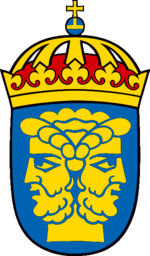National Archives of Sweden
| Template:Lang-sv | |
 | |
| Agency overview | |
|---|---|
| Formed | 1618[1] |
| Jurisdiction | Government of Sweden |
| Headquarters | Stockholm, Sweden |
| Minister responsible | |
| Website | riksarkivet |
The National Archives of Sweden (Swedish: Riksarkivet, RA) is one of the oldest public agencies in Sweden, with its origins in the Middle Ages. The chief of Riksarkivet is called the Riksarkivarie.
History
The National Archives is one of the oldest continuously active institutions in Sweden, with roots that can be traced back to the 1200s. On October 18, 1618 Axel Oxenstierna the Lord High Chancellor (Rikskansler) of the Privy Council established the National Archives as an independent body of state within the Royal Chancellery replacing the Old Office.
A huge setback occurred in 1697 with the disastrous Tre Kronor castle fire in Stockholm. Only a small part of the Archives could be salvaged from the flames and the collection of medieval documents was severely depleted.
Regional Archives, mergers with other archives
The National Archives was originally limited to the royal office, but from the late 19th century the National Archives also got responsibility for archives of other central and local authorities. The National Archives functioned as chief authority over the different regional archives: the Provincial Archives of Vadstena that opened in 1899, Lund and Uppsala that both opened in 1903, Visby in 1905, Gothenburg in 1911, Östersund in 1928, and finally in 1935 in Härnösand.
Since 1963, the Royal Palace Archives at Stockholm Palace has been a section under the National Archives. In 1995 the formerly independent authority, the Military Archives, was made a department of the National Archives.
The National Herald Board
The National Herald Board was closed in 1953, and the state's heraldic operations continued as a department under the National Archives. The department deals with questions about coat of arms design, flags and emblems and continuously produces new heraldic images for newly formed governmental bodies, counties, etc. The National Herald Topic of office of the Manager held the title of National Herald, but in the new organization the title instead became State Herald (statsheraldiker).
Holdings
The oldest document in the National Archives (listed in 2005) is a parchment from a missal, written in England in the late 10th century. The document came to Sweden via the British Christian missionary in Norway.
In 2015 the archival holdings amounted to approximately 750 shelf kilometers - comprising mainly parchment and paper. The digital media holdings included 130 million digital images. The amount of documents increases continuously because of the delivery of documents from the Cabinet Office and other central agencies. There are also personal archives, archives of associations and also some company archives.
The National Archives is subject to open government, which means that the holdings in general are available to the public - including researchers and research-related individuals. The exception is made for confidential documents or certain perishable older material. Many of the oldest documents are, however, reproduced on microfilm or as digital images.
Novgorod Occupation Archives
The "Novgorod occupation archives" (Swedish: Ockupationsarkivet från Novgorod) is the name used since the 1960s for a unique collection of documents in the National Archives. They are written in Russian by Russian administrators of the city of Veliky Novgorod during the years 1611-1617 when the Swedish army occupied the city. The documents include both originals and copies that were intended to be sent to Moscow. When the Swedish army withdrew from the city, the commander Jacob De la Gardie collected these documents as useful evidence for the peace negotiations and brought them back to his quarters in Estonia. Later the collection was sent to Stockholm, where its importance as a source of Russian history was recognized in the mid-19th century. They were first catalogued in 1964 by Russian historian Sergei Dmitrievsky. An improved catalogue was printed and published in 2005.[2] The documents (which comprise 30,000 pages) were initially microfilmed, and the monochrome microfilm later digitized. This digital archive is available online. The collection consists of two series. Series 1 has 141 books and series 2 has 368 scrolls.[3][4]
See also
References
- Borgkvist Ljung, Karin; Anna Fornäs. "The Swedish National Archives" (PDF). Retrieved 31 January 2012.
- ^ http://riksarkivet.se/historik
- ^ Elisabeth Löfstrand, Laila Nordquist, Accounts of an Occupied City : Catalogue of the Novgorod Occupation Archives, Series I, Skrifter utgivna av Riksarkivet 24 (2005), series II, Skrifter utgivna av Riksarkivet 31 (2009).
- ^ Ockupationsarkivet från Novgorod, website of the National Archives, in Swedish, visited October 19, 2014.
- ^ Ockupationsarkivet från Novgorod, website of Stockholm University, department of history, in Swedish, visited October 19, 2014.
